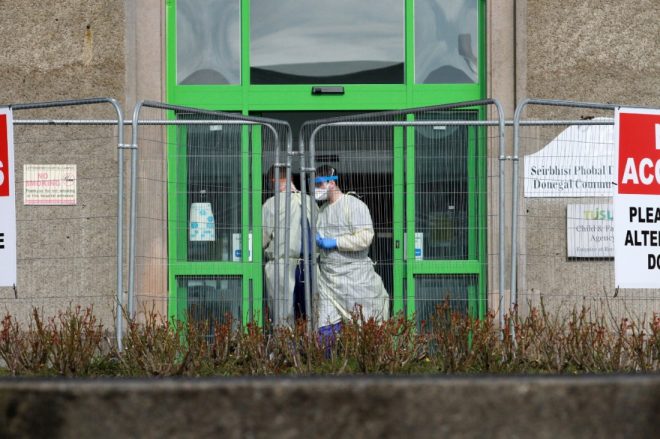
Cases by county
| Carlow | 92 | 0.5% |
| Cavan | 609 | 3.2% |
| Clare | 212 | 1.1% |
| Cork | 1125 | 5.9% |
| Donegal | 452 | 2.4% |
| Dublin | 9532 | % |
| Galway | 335 | 1.8% |
| Kerry | 288 | 1.5% |
| Kildare | 1127 | 5.9% |
| Kilkenny | 233 | 1.2% |
| Laois | 205 | 1.1% |
| Leitrim | 66 | 0.3% |
| Limerick | 457 | 2.4% |
| Longford | 129 | 0.7% |
| Louth | 627 | 3.3% |
| Mayo | 464 | 2.4% |
| Meath | 626 | 3.3% |
| Monaghan | 373 | 2% |
| Offaly | 228 | 1.2% |
| Roscommon | 135 | 0.7% |
| Sligo | 114 | 0.6% |
| Tipperary | 364 | 1.9% |
| Waterford | 137 | 0.7% |
| Westmeath | 446 | 2.4% |
| Wexford | 162 | 0.8% |
| Wicklow | 557 | 2.9% |
*All statistics measured at midnight on Friday 24 April 2020.
The Health Protection Surveillance Centre has today been informed that a total of 18 people with Covid-19 have died, of which 17 were laboratory confirmed.
There have now been a total of 1,102* Covid-19 related deaths in Ireland.
As of 11am Monday 27th April, the HPSC has been notified of 386 new confirmed cases of Covid-19. There is now a total of 19,648 confirmed cases of Covid-19 in Ireland.
The HSE is working to identify any contacts the patients may have had to provide them with information and advice to prevent further spread.
Today’s data from the HPSC, as of midnight, Saturday 25th April (19,095 cases), reveals:
· 57% are female and 42% are male
· the median age of confirmed cases is 49 years
· 2,625 cases (14%) have been hospitalised
· Of those hospitalised, 353 cases have been admitted to ICU
· 5,204 cases are associated with healthcare workers
· Dublin has the highest number of cases at 9,532 (50% of all cases) followed by Kildare with 1,127 cases (6%) and then Cork with 1,125 cases (6%)
· Of those for whom transmission status is known: community transmission accounts for 63%, close contact accounts for 33%, travel abroad accounts for 4%
Dr. Tony Holohan, Chief Medical Officer, Department of Health, said: “We have always made it clear that there are certain things that we need to be satisfied with prior to recommending any change in current restrictions. The most important one is that the incidence rate of the virus needs to be as low as possible in terms its transmission in the community and within community and residential settings. In addition, the impact of the disease on rates of mortality and hospitalisations including admissions to intensive care units also needs to be at a very low level.
“Improvements are still needed in these important measures.”
Dr Siobhán Ní Bhriain, Consultant Psychiatrist and HSE Integrated Care Lead, said: “We are very aware how difficult the current restrictions are for people and families. There are a number of supports available on gov.ie/together and yourmentalhealth.ie so please use these facilities and contact your GP if you are very stressed.”










